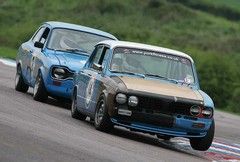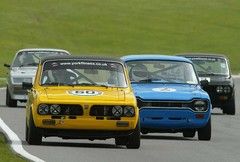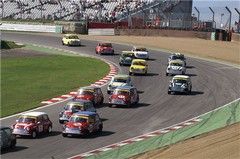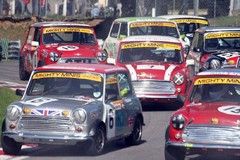Cheap as chips racing
Ever wanted to go racing without losing a fortune? Nick Hall has some ideas.

Locost racing
If you’re combing the classifieds for that perfect trackday toy under £10,000 and are longing for the day when you can round Paddock Hill Bend on an armful of opposite lock, waving to the adoring and largely imaginary crowd, then this could complicate your life. For that money, you can go racing.
We’re not talking lawnmower battles on the village green either, or the myriad of autotests, kart championships and other competitive sports that can be had for a fraction of that money and are just as valid in their own right. These are bona fide national circuit championships, and a full year can be yours for the price of a world weary Lotus Elise, right down to the car, entry fees, overalls, trailer and race licence.
If you’re fond of crashing, buzzing engines or running at the head of the pack then throw these numbers out the window. Motorsport can cost your life savings, sanity and house faster than a cocaine diet if you let it. Even the cheapest forms of racing have those looking to buy that extra tenth of a second and some annoying soul will spend your whole budget on tyres.
But if you just want to compete, have some fun and call yourself a racing driver, then there are more sub-10K options than species of ant. Well there aren’t, but you know...
There are plenty more and we all have favourites, but here are just a few to whet your appetite:
Locost Racing
- Web: www.750mc.co.uk
- Car: £3,000+
- Estimated first year costs: £5,000
Ron Champion became a legend with his book How to Build a Sportscar for £250. While that’s about as optimistic for a competitive race car as a Jade Goody peacekeeping mission to India, you can still do this series on the cheap.
In the UK it’s run by the 750 Motor Club, which is the heart and soul of budget motor racing in the UK and the car is built from old Ford bits, so spares are relatively cheap. The Locost weighs less than an anorexic ballerina, so the 1300cc Crossflow is more than good enough for 105mph and with everyone driving roughly the same equipment you’re guaranteed some wheel-to-wheel action – or abject humiliation.
It looks like a Caterham, is more fun than should be allowed and you’ll get a season’s racing comprising nine meetings with three double headers. Keep it out the wall and by the end you should have a trackday car and lots of change from £9,000. Still want the Elise?
Classic Touring Car Racing
- Web: www.classictouringcars.com
- Car: £1,500+
- Estimated first year budget: £6,000
Have a penchant for something big and rear wheel drive? The Classic Touring Car Club has the answer in the pre-’93 Touring Car class.
If it had four seats and was marketed before ’93, with a few exceptions, then you can race it in one of six classes catering for cars up to and beyond 3.5 litres. The Auto Trader’s bargain bucket section, even PistonHeads' Shed of the Week, is a good place to start as the open market is flooded with Rover SD1s, Capris and even BMW 7 Series out there just waiting for a new lease of life.
A fully race-prepped car can come in well under £2,000 and, as long as it has a rollcage and fire extinguisher, it’s pretty much good to go for 10 race meetings and some old school tailsliding fun. You can enter a front-drive Golf, or just about anything else for that matter, it’s not a hardcore, exclusive sorority.
The Production BMW class looks like a winner for anyone counting pennies together for a racing budget and with 10 meetings. If that beaten old 316 won’t make it past the next MOT, strap on some numbers to it and take it racing.
Formula Vee
- Web: www.750mc.co.uk
- Car: £4,000
- Entry fees: £1,650
Some of the world’s greatest drivers started out in Formula Vee, including Niki Lauda, Jochen Rindt and Keke Rosberg, but now it is firmly in the hands of the clubman racer as an alternative to the more expensive Formula Ford.
With 16 rounds on pretty much every major race track in the nation, this series is top value for money and while the car isn’t eligible for trackday entertainment, you can go general testing and have a blast.
No road car, converted or otherwise, can hold a candle to the sheer exhilaration of a purpose-built single-seater and you’ll wonder how you even thought about anything else when you’re barrelling down the main straight at 130mph with cars darting every which way and insects exploding with nuclear force on your visor.
This is pretty much as close as circuit racing gets and huge grids means that somebody has to be the same standard, so you’re bound to have fun.
Accidents are more likely and with open-wheel cars can lead to a Freejack-style airborne moment, which at best will prove expensive, and tyres and set-up make a bigger difference. But it’s a friendly series and information, if not rubber, will be shared freely.
And you can sell it on at the end of the year for pretty much what you paid, more if you win.
Porsche Open Championship
- Web: Porsche Club Motorsport
- Car: £4,000
- Estimated budget: £6,000
Now surely this is reaching too far? Well if you forget about the house-priced 800bhp+ 911s at the head of the field and opt for a Class 4 944 then yes, you’ll easily do a season on under £10,000 and once again end up with a perfectly serviceable trackday car when you’re done.
Minimal modifications are allowed in the series and horsepower is limited to 196, so it’s a good place for novice racers to find their wings. It’s important to start with the best car you can afford, but once it’s paid for then safety mods are pretty much all that’s allowed and the rest is up to you.
Be prepared to get blown off the track, as you’ll run with the big boys, but the race within a race in front of a big crowd is all part of the fun. Buzz an engine or crash the car and prepare to weep, Porsche repairs don’t come cheap whatever the car’s vintage, but what a great way to start racing.
The genius part is that if you really take to Porsche racing you can trick up the car, move up in class, win the club championship and a free prize drive in the Porsche Carrera Cup is yours for the taking. From there, Le Mans awaits -- maybe.
Mighty Minis
- Web: www.mightyminis.co.uk
- Car: £2500+
- Estimated Budget: £7,500
Not only do you get to race the most well-loved car in the known world, Class A of the Mighty Mini Championship was crafted with beginners in mind and the front-drive option might simply suit some drivers’ style better.
Any single-point injection Mini Cooper built between 1991 and 1996 can enter and modifications are kept to the bare minimum. Yokohama tyres and Gaz shock absorbers the only real performance mods allowed, and everybody has them, beyond that it’s a case of buying a strong base car and heading out there to have fun,
There are eight meetings in 2007 with four double-headers, so there’s plenty of racing to be done, and with such minimal modifications you could almost certainly tax it and drive it to the circuit.
Pictures by Paul Williams (Touring Cars) and Steve Williams (750MC and Locost). Other pics courtesy of race series.
Gassing Station | General Motorsport | Top of Page | What's New | My Stuff












